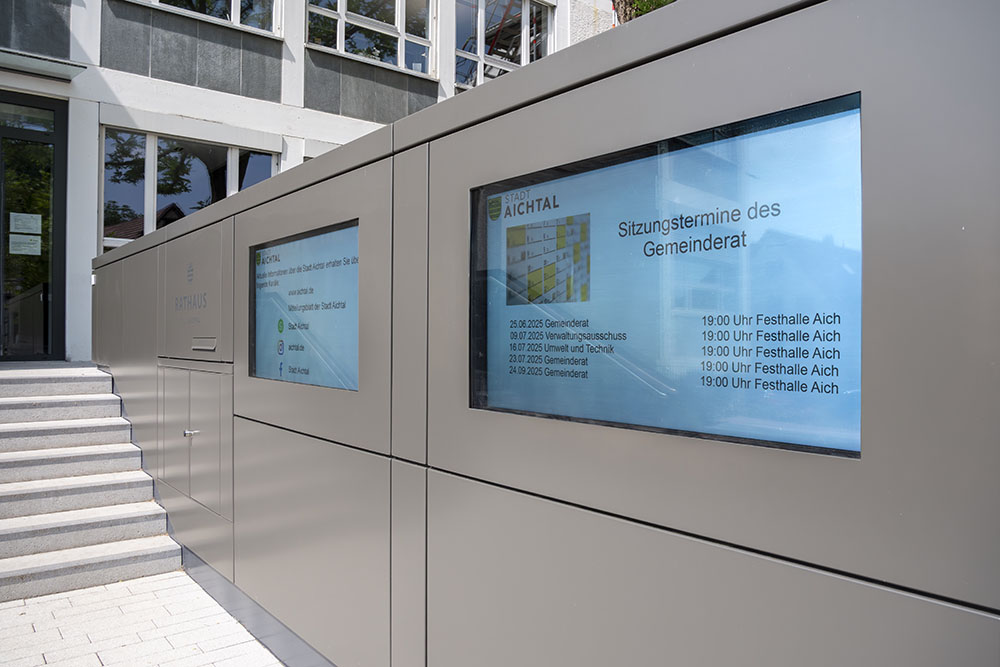

Effective point of sale marketing can significantly help increase sales and influence purchasing decisions directly at the point of sale. Especially in stationary retail, companies are specifically using POS advertising and sales displays to optimally present their products and services.
Through modern technologies such as digital signage , content can be adapted flexibly and designed interactively. Digital screens, interactive POS systems and a well-thought-out digital signage software enable even more targeted customer communication and ensure an improved shopping experience.
The Point of Sale (POS) is where customers directly interact with a product or service and make a purchase decision. This term includes both physical locations like retail stores and digital sales platforms like online shops.
Closely related is the term Point of Purchase (POP), which describes the area where customers are actively encouraged to buy. The POS is a crucial touchpoint where companies strategically use POS marketing measures to influence purchasing decisions.
POS marketing includes all marketing activities used directly at the POS to specifically influence customers' purchasing decisions. This includes digital customer stoppers, digital signage displays, discount promotions, and visual merchandising.
The goal is to draw attention to specific products, encourage impulse buys, and optimize the shopping experience through targeted POS advertising. In particular, digital signage solutions enable flexible and dynamic implementation of these strategies by adapting content in real-time and displaying personalized advertising.

POS marketing differs depending on the business model.
In the B2B sector (Business-to-Business), it often involves product presentations at trade fairs, in showrooms, or specialist shops. Companies use digital POS solutions to present complex products interactively and informatively.
In the B2C sector (Business-to-Consumer), the POS is used directly to guide purchasing decisions. POS terminals, mobile POS solutions, and interactive displays are used to attract potential customers and promote sales.
Successful POS marketing combines appealing product presentation, targeted advertising, and interactive elements to reach potential customers directly at the point of sale. Digital POS solutions enable companies to flexibly adapt content, control special promotions in real-time, and set targeted purchase incentives.
A well-placed sales display can highlight specific products and focus customer attention. Compared to static advertising media, digital advertising spaces and interactive touchscreens offer the advantage that content can be updated and personalized in real-time.
A well-thought-out store design and visual merchandising are essential for success at the POS. The strategic placement of products, appealing lighting, and the integration of digital signage displays create a modern and dynamic sales environment. Moving images, animations, and interactive elements not only increase customer loyalty but also the amount of time spent in the store.
Targeted discounts, special promotions, and personalized offers are proven methods to encourage impulse purchases. Digital price tags, LED advertising pylons, and digital menu boards enable quick adaptation of offers and targeted customer communication. In this way, POS systems and modern Point of Sale software can react in real-time to seasonal offers, daily discounts, or individualized advertising campaigns.
With interactive POS terminals customers can directly access information about products, view ratings, or place orders. This technology not only increases convenience but also optimizes the purchase decision. Digital customer stoppers and digital menu boards are particularly popular in the gastronomy sector, as they automatically adapt content depending on the time of day, thus offering a high degree of flexibility.
Through the combination of visual presentation, interactive elements, and flexible price adjustments, the Point of Sale (POS) becomes an even more effective sales tool.
A powerful POS terminal ensures fast and efficient purchase processing. Modern POS software enables easy management of inventory, transactions, and customer profiles.
Mobile POS (mPOS) solutions enable businesses to accept payments flexibly right at the point of sale. This allows employees to provide more personalized customer service and reduce waiting times.
Using a barcode scanner allows for quick product capture. At the same time, digital payment systems offer secure and convenient processing for customers.
A successful POS marketing concept is based on a clearly defined target group. Companies should analyze which products or services are particularly relevant to their customers and tailor their POS advertising accordingly.
💡An Example:
A café or bakery can use digital menu boards to automatically adjust the offerings depending on the time of day. In the morning, the focus is on breakfast items such as croissants and coffee specialties, while at lunchtime, savory snacks and lunch menus are promoted.

✅ Use Visual Stimuli: High-quality images, animations, and videos spark interest.
✅ Incorporate Interactive Elements: Touchscreens or QR codes actively involve customers.
✅ Display Personalized Advertising: Content can be specifically tailored using POS software.
✅ Utilize an Omnichannel Strategy: Linking to an online shop enables a seamless shopping experience.
✅ Regular Updates: Content on digital signage displays should always be up-to-date and relevant.
POS stands for "Point of Sale" and refers to the location where targeted marketing measures are used to increase sales. Through strategies such as POS advertising, digital sales displays, and interactive promotions, companies can trigger purchase impulses and strengthen brand presence.
In retail, POS describes the place where customers come into direct contact with products and make a purchase decision. This can be a store, a supermarket, or a pharmacy, where targeted POS marketing measures draw attention to specific products.
POS concepts are strategies and measures that design the point of sale in such a way that it positively influences the purchasing decisions of customers. This includes the optimal placement of products, appealing visual merchandising, as well as digital solutions such as interactive displays or dynamic price tags.
At the POS, companies can use various forms of advertising to specifically target customers and create purchase incentives. In addition to classic methods such as posters or product placements, digital advertising displays, interactive terminals, and LED steles offer the possibility to flexibly adapt content and display personalized advertising.

In-house design agency at Wedeko: We develop visual content that not only stands out but is also understood.

The city of Aichtal has taken a big step forward in terms of citizen information with a digital signage system from Wedeko.